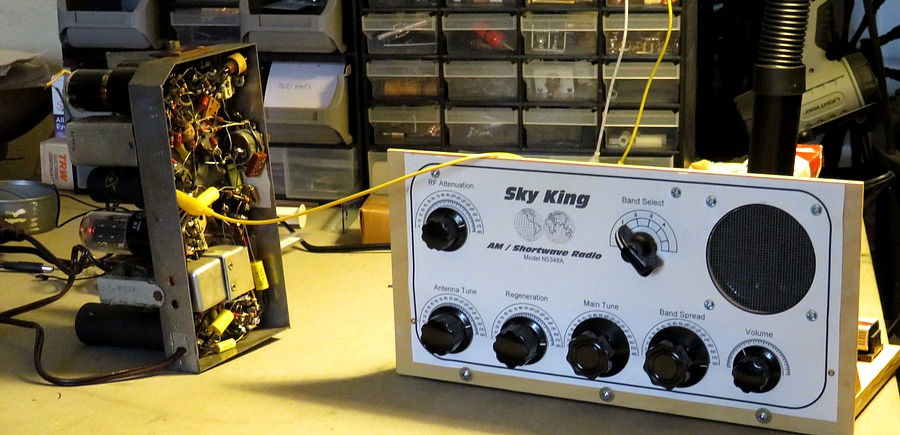 |
Westinghouse
model H-126
"Little Jewel" |
 |
|
|
|
|
|
| I turned the radio on.
The pilot light lit brightly and then dimmed. A good sign.
Then... as the vacuum tubes warmed up, the humming began. 60
cycle humming.
I had tested the filter capacitors
before I installed them. What had gone wrong? My head hung
in woe. The radio worked before I messed with it. Now it was
ruined. RUINED!!
To make matters worse, I "shared the experience" with
Andrea. So when the radio emitted a loud humming instead of
a radio station, she probably thought, 'LOOOO-ZER!" I didn't
want to look at her, in case she was making that "loser" gesture on her forehead
behind my back. It would have been so
humidifying.
|
|
|
LOOOO-ZER!
|
|
Flummoxed and bewildered, I began to trace the
connections against the schematic. It turned out I had mixed up two
red wires.
How can you mix up two wires? Because they are
both red? Actually, I had set a time bomb ticking on the day I
started working on the radio, and it had gone off. I drew a diagram of the tubes as they
looked from the bottom. I transposed two of the tubes in the
drawing. |
|
|
|
|
|
After fixing the
mistake, the radio worked. Now it was time to start adjusting
the set. Since I don't have a frequency generator, I do it
by ear. That means none of my radios work as well as they
could, because there is no way to tell if the local
oscillator is actually at 455 kilocycles. With patience and
a lot of tuning back and forth and adjusting the
transformers I think you can get pretty
close.
Then the dial cord broke.
This was a good thing. Better it
break now than after everything is put back together. Also,
you can tune the dial ten times faster while making
adjustments.
|
|
 |
While I was looking for
the dial cord I bought five years ago and now couldn't find,
I had an idea. I grabbed the Sony ICF-7600D, which has a
digital readout, and tuned it to 455 kilocycles. Then I took
the Sky King regenerative radio and tuned it down till the Sony
picked up the high
pitched tone. (A regen radio oscillates at whatever
frequency it is tuned to.) I attached a clip lead to the antenna
terminal of the Sky King and used it as a signal generator.
I followed the alignment instructions, somewhat. The lead
from the regen radio, now set at approx. 455 kHz, was
connected to the control grid of the 12SF7, and the I.F.
transformers were adjusted till the sound was loudest. Then
the wire was connected to the control grid of the 12SA7 and
the I.F. transformers were adjusted again.
I have to say, I had it darn close just by doing it by ear
the night before.
The stations on the dial were really off. To set the dial, I
tuned to the highest station the radio could get, which was WCHE at 1520
kHz. I backed out the screw on the tuning condenser and
started "walking" WCHE down the dial till I could
pick up 1640 (Pennsylvania Turnpike). Then I walked 1640 down the dial a
bit and then tuned to 560 (WFIL) to make sure I could still
pick it up. |
|
|
|
|
|
|
|
|
The new dial cord is twice as thick. I
dare it to break. "How ya like me now? PUNK!"
|
|
There must be some secret trick to winding a new
dial cord. This took me over an hour after two failed attempts.
Can you believe it broke after 70 years? It's the only break I got
with
this radio. |
|
| |
|
|
|
Time for some labels.
These were printed with an ink jet printer, then given a
coat of satin polyurethane. To get the gold label, a piece
of printer paper was sprayed with gold paint. Unfortunately,
the ink jet ink doesn't show up on the paint. I put the gold
paper in the paper tray of a copy machine and made a copy.
|
|
|
|
|
|
|
|
This was
the only label hard to make. UL doesn't make them in color
anymore
and I couldn't find one on the Internet. Finally, someone
posted a
picture of
the
bottom of an old washing machine, and it had the UL logo
on it!
It was damaged but repaired with some virtual surgery. |
|
|
|
It almost looks original! |
|
|
|
|
|
|
Here are some Before and After pictures. |
|
|
|
|
|
|
|
|
|
|
|
|
|
| |
|
| |
|
|
| |